The 2006 Toyota Sequoia is a full-size SUV that was popular for its spacious interior, capable performance, and reputation for reliability. It was designed to cater to families and individuals who needed a vehicle with ample cargo space, towing capacity, and off-road capability.
This generation of the Sequoia was known for its robust build quality, comfortable ride, and powerful engine options. The 2006 Sequoia was also praised for its safety features and overall reliability. It became a popular choice for those seeking a dependable and capable SUV for everyday use and weekend adventures.
The 2006 Toyota Sequoia: A Powerful Full-Size SUV
The 2006 Toyota Sequoia is a full-size SUV known for its spacious interior, powerful engine, and rugged capabilities. It was a popular choice for families and individuals seeking a vehicle that could comfortably accommodate passengers and cargo while also handling tough off-road conditions.
The Sequoia was designed to cater to a wide range of needs, from everyday commuting to weekend adventures.
Key Features of the 2006 Toyota Sequoia
The 2006 Toyota Sequoia came standard with a 4.7-liter V8 engine producing 276 horsepower and 330 lb-ft of torque. This powerful engine provided ample acceleration and towing capacity, making it suitable for hauling trailers and boats. The Sequoia was also available with a variety of features that enhanced its comfort, convenience, and safety, including:
- Spacious Interior:The Sequoia offered three rows of seating, accommodating up to eight passengers comfortably. The interior was well-appointed, with ample legroom and headroom for all passengers.
- Advanced Safety Features:The Sequoia included standard safety features such as anti-lock brakes (ABS), electronic brakeforce distribution (EBD), and vehicle stability control (VSC). These features helped to enhance the vehicle’s safety and stability on the road.
- Off-Road Capability:The Sequoia was equipped with a four-wheel-drive system that provided excellent traction and handling on rough terrain. It also featured a high ground clearance and a robust suspension system, making it capable of tackling challenging off-road conditions.
- Towing Capacity:The Sequoia had a maximum towing capacity of up to 7,400 pounds, making it suitable for towing trailers, boats, and other heavy loads.
- Versatile Cargo Space:The Sequoia’s spacious cargo area could accommodate a significant amount of luggage, equipment, or other items. The rear seats could be folded down to further increase cargo space.
Target Audience for the 2006 Toyota Sequoia
The 2006 Toyota Sequoia was designed to appeal to a diverse range of individuals and families who needed a powerful, spacious, and versatile SUV. Its key target audience included:
- Families:The Sequoia’s spacious interior and numerous safety features made it an attractive option for families with multiple children or those who frequently travel with extended family members.
- Outdoor Enthusiasts:The Sequoia’s off-road capabilities and towing capacity made it ideal for individuals who enjoyed camping, fishing, or other outdoor activities that required a vehicle that could handle tough terrain and haul equipment.
- Professionals:The Sequoia’s comfortable interior and advanced features made it a suitable choice for professionals who needed a reliable and spacious vehicle for business travel or commuting.
Design and Styling

The 2006 Toyota Sequoia was designed to be a powerful and capable full-size SUV, offering a rugged exterior and a spacious and comfortable interior. It was built on the same platform as the Toyota Tundra pickup truck, which gave it a robust and durable foundation.
Exterior Design
The 2006 Toyota Sequoia featured a bold and imposing exterior design, characterized by its large dimensions and muscular lines. It was a full-size SUV with a length of 204.3 inches, a width of 79.1 inches, and a height of 75.2 inches.
Its wheelbase measured 119.1 inches, providing ample space for passengers and cargo. The front fascia featured a prominent grille with horizontal chrome bars, flanked by large headlights and a substantial bumper. The side profile showcased a straight beltline, flared wheel arches, and a sloping roofline that contributed to its aerodynamic design.
The rear end was equally imposing, with a wide tailgate, large taillights, and a substantial bumper. The Sequoia’s overall design was designed to convey a sense of strength and capability, reflecting its intended role as a versatile and capable SUV.
Interior Design
The interior of the 2006 Toyota Sequoia was designed to prioritize comfort, functionality, and spaciousness. It offered seating for eight passengers, with three rows of seats. The materials used in the interior were of good quality, with durable fabrics and plastics.
The dashboard was designed with a driver-focused layout, featuring a large instrument cluster and a center console with a prominent gear selector. The Sequoia also offered a range of features to enhance comfort and convenience, including power windows, power locks, air conditioning, and a premium sound system.
The second-row seats could be folded down to increase cargo space, while the third-row seats could be removed entirely to create even more room for cargo.
The 2006 Toyota Sequoia, a full-size SUV known for its ruggedness and spacious interior, shares a legacy with Toyota’s legendary pickup trucks. While the Sequoia is a modern behemoth, its roots can be traced back to the iconic 1989 Toyota Hilux , a vehicle synonymous with durability and off-road capability.
The Sequoia, like its ancestor, continues to be a reliable choice for those seeking a powerful and versatile vehicle, though it has evolved to offer modern amenities and safety features.
Performance and Handling
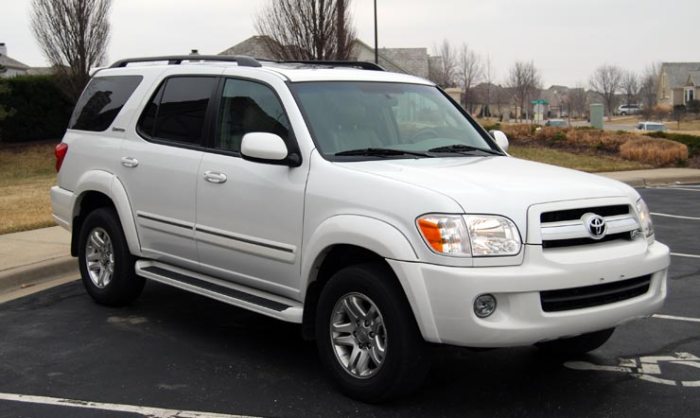
The 2006 Toyota Sequoia is a powerful full-size SUV designed for both on-road comfort and off-road capability. Its performance and handling characteristics are influenced by its engine options, fuel efficiency, towing capacity, and overall driving dynamics.
Engine Options and Performance
The 2006 Toyota Sequoia offered two engine choices, both providing ample power for its size and purpose.
- 4.7L V8 Engine:This engine, standard on the SR5 and Limited trims, produced 270 horsepower and 325 lb-ft of torque. It provided a balance of power and fuel efficiency for everyday driving.
- 5.7L V8 Engine:The optional 5.7L V8, available on the Platinum trim, delivered 381 horsepower and 401 lb-ft of torque. This engine offered a significant power boost for towing and off-road adventures, making it a popular choice for those seeking maximum performance.
Fuel Efficiency and Towing Capacity
Fuel efficiency was a consideration for the 2006 Sequoia, particularly with its size and weight.
- Fuel Efficiency:The 4.7L V8 engine achieved an EPA-estimated fuel economy of 14 mpg city and 19 mpg highway. The 5.7L V8 engine, while more powerful, had a slightly lower fuel economy of 13 mpg city and 17 mpg highway.
- Towing Capacity:The 2006 Sequoia was built for towing. The 4.7L V8 had a maximum towing capacity of 7,400 pounds, while the 5.7L V8 boasted a towing capacity of 8,500 pounds.
Handling and Ride Quality
The 2006 Toyota Sequoia provided a comfortable ride for passengers while maintaining a stable handling experience.
- Ride Quality:The Sequoia’s independent front suspension and solid rear axle with coil springs provided a smooth ride, absorbing bumps and uneven roads effectively. Its large size and weight contributed to a stable and comfortable ride for passengers.
- Handling:The Sequoia’s handling was well-suited for its intended purpose. It was stable at highway speeds and maneuvered reasonably well in city traffic. While not as agile as a smaller SUV, the Sequoia’s size and weight provided a sense of security and stability.
Safety Features
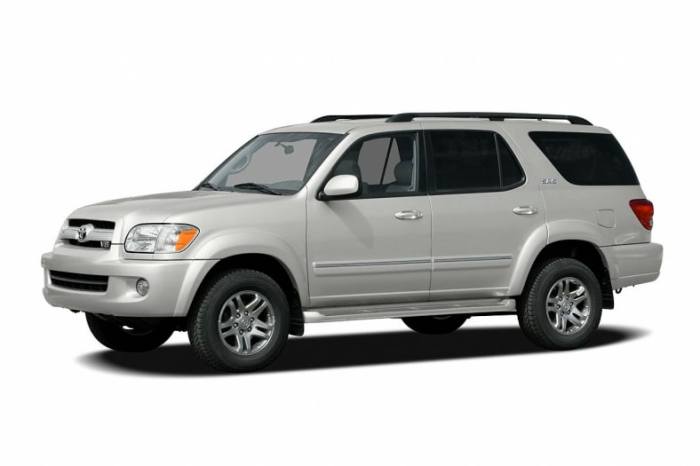
The 2006 Toyota Sequoia was designed with a comprehensive suite of safety features to protect occupants in the event of a collision. The standard and optional features aimed to provide a safe driving experience for both the driver and passengers.
Standard Safety Features
The 2006 Toyota Sequoia came standard with a robust set of safety features, including:
- Anti-lock Braking System (ABS):This system prevents wheel lockup during braking, allowing for better steering control and shorter stopping distances.
- Electronic Brakeforce Distribution (EBD):This system automatically adjusts braking force to each wheel based on the vehicle’s load and conditions, optimizing braking performance.
- Brake Assist:This feature automatically increases braking force when it senses an emergency stop, helping to reduce stopping distances.
- Vehicle Stability Control (VSC):This system helps to maintain control of the vehicle during slippery conditions by applying brakes to individual wheels and reducing engine power.
- Traction Control (TRAC):This system helps to prevent wheel spin by reducing engine power and applying brakes to individual wheels.
- Dual Front Airbags:These airbags are designed to protect the driver and front passenger in the event of a frontal collision.
- Front Side Airbags:These airbags are designed to protect the driver and front passenger in the event of a side impact collision.
- Side Curtain Airbags:These airbags are designed to protect all occupants in the event of a rollover or side impact collision.
- Three-Point Seatbelts for All Seats:This feature helps to keep occupants secure in the event of a collision.
- Child Safety Locks:These locks prevent children from opening rear doors from the inside.
Optional Safety Features
Beyond the standard features, Toyota offered several optional safety enhancements for the 2006 Sequoia, including:
- Rear Parking Sensors:These sensors help to alert the driver to objects behind the vehicle while parking.
- Rearview Camera:This feature provides a visual display of the area behind the vehicle, aiding in parking and maneuvering.
- Navigation System:While primarily for navigation, some navigation systems included safety features such as lane departure warning and blind spot monitoring.
Safety Ratings
The 2006 Toyota Sequoia received positive safety ratings from the National Highway Traffic Safety Administration (NHTSA) and the Insurance Institute for Highway Safety (IIHS). The NHTSA awarded the Sequoia five stars out of five in frontal crash testing and four stars in side crash testing.
The IIHS gave the Sequoia a “Good” rating in its frontal offset crash test.
“The 2006 Toyota Sequoia was a relatively safe vehicle for its time, with a strong set of standard safety features and positive ratings from independent safety organizations.”
The 2006 Toyota Sequoia is a robust SUV that embodies the brand’s reputation for reliability and durability. While the Sequoia is known for its modern features and spacious interior, it’s worth remembering the legacy of its predecessor, the 1969 Toyota Land Cruiser , a rugged off-roader that established Toyota’s reputation for building vehicles that could handle any terrain.
The Sequoia, in its own way, carries on that legacy, offering a blend of comfort and capability that makes it a popular choice for families and adventurers alike.
Notable Safety Advancements
The 2006 Toyota Sequoia featured several notable safety advancements, including:
- Vehicle Stability Control (VSC):This system was becoming increasingly common in vehicles at the time and was a significant safety advancement, helping to prevent rollovers and maintain control in slippery conditions.
- Side Curtain Airbags:These airbags were also becoming more common and provided enhanced protection for all occupants in the event of a rollover or side impact collision.
Reliability and Durability
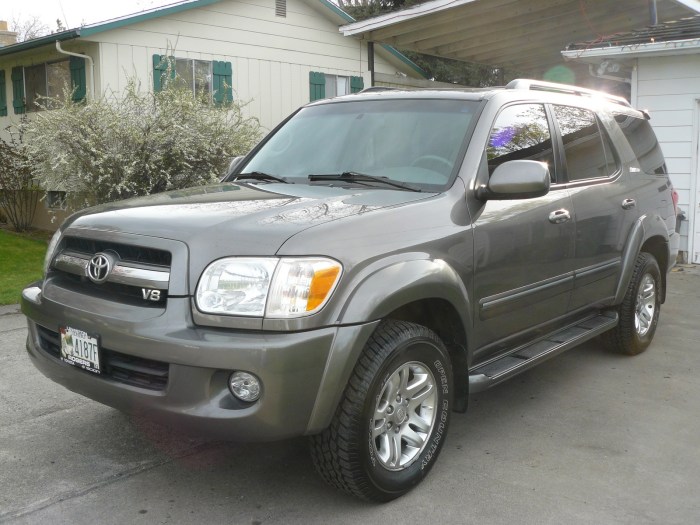
The 2006 Toyota Sequoia is known for its robust build quality and reliability, making it a popular choice among families and adventurers seeking a dependable full-size SUV. Toyota has consistently ranked high in reliability studies, and the Sequoia is no exception.
Its reputation for durability is further cemented by its robust construction and use of high-quality materials.
Common Maintenance Needs
Regular maintenance is crucial for any vehicle, especially for a large SUV like the Sequoia. Here are some common maintenance needs:
- Oil Changes:Frequent oil changes are essential for maintaining engine health. Toyota recommends oil changes every 5,000 miles or 6 months, whichever comes first.
- Air Filter Replacement:A dirty air filter can restrict airflow to the engine, reducing performance and fuel efficiency. Replacing the air filter every 12,000 miles or 12 months is recommended.
- Tire Rotation and Balancing:Rotating and balancing tires helps ensure even wear and prevents vibrations. Toyota recommends rotating tires every 6,000 miles.
- Brake Inspections and Replacement:Regular brake inspections are vital for safety. Brake pads and rotors should be inspected every 6,000 miles and replaced as needed.
Potential Issues
While the 2006 Sequoia is generally reliable, some common issues have been reported.
- Transmission Problems:Some owners have reported transmission issues, such as slipping or rough shifting. This could be due to worn-out transmission fluid or internal transmission problems.
- Suspension Problems:The Sequoia’s suspension system can wear out over time, leading to noises, vibrations, or a bouncy ride. Replacing worn-out components is essential for maintaining a smooth and safe ride.
- Electrical Problems:Electrical problems, such as faulty sensors or wiring issues, can occur in any vehicle. If you notice any unusual electrical behavior, it’s important to have it diagnosed and repaired by a qualified mechanic.
Technology and Features
The 2006 Toyota Sequoia was equipped with a range of technology features that aimed to enhance convenience, entertainment, and safety for its passengers. While not as advanced as modern vehicles, its technology offerings were still considered competitive for its time.
Infotainment System
The 2006 Sequoia came standard with an AM/FM stereo with a CD player. An optional JBL premium sound system with a 6-disc CD changer and a 10-speaker setup was also available. While not equipped with a touchscreen or smartphone integration, the infotainment system provided a basic level of entertainment and connectivity.
Navigation
Navigation was not standard equipment on the 2006 Sequoia. However, it was available as an optional feature, providing drivers with turn-by-turn directions and mapping capabilities. The navigation system was integrated with the vehicle’s audio system, allowing for voice guidance and route information to be displayed on the audio system’s screen.
Driver Assistance Features
The 2006 Sequoia offered a limited number of driver assistance features. These included:
- Anti-lock Braking System (ABS):This feature prevented wheel lockup during braking, helping to maintain control of the vehicle in slippery conditions.
- Electronic Brakeforce Distribution (EBD):This system automatically adjusted brake pressure to each wheel, ensuring optimal braking performance in various situations.
- Vehicle Stability Control (VSC):This feature helped maintain control of the vehicle during sudden maneuvers or slippery conditions by applying brakes to individual wheels and reducing engine power.
- Traction Control (TRAC):This system prevented wheel slippage during acceleration, improving traction and control on slippery surfaces.
While these features were not as comprehensive as those found in modern vehicles, they provided a basic level of safety and driver assistance for the time.
Ownership Experience
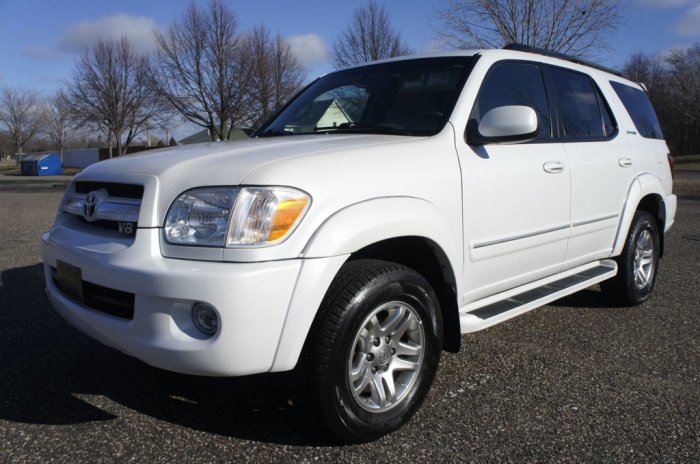
The 2006 Toyota Sequoia, known for its robust build and spacious interior, has garnered a loyal following among owners. These owners have shared their experiences, highlighting the vehicle’s strengths and weaknesses, offering valuable insights for potential buyers.
Reliability and Durability
Owners consistently praise the 2006 Toyota Sequoia for its remarkable reliability and durability. Many report experiencing minimal issues throughout their ownership, even after driving for hundreds of thousands of miles. The vehicle’s robust construction, coupled with Toyota’s reputation for quality, contributes significantly to its long-lasting performance.
The 2006 Toyota Sequoia, a full-size SUV, is known for its spacious interior and powerful engine. While the Sequoia is a modern vehicle, it shares a lineage with the iconic Toyota Land Cruiser, a vehicle known for its off-road prowess.
The 1967 Toyota Land Cruiser , for example, was a rugged and reliable off-roader that paved the way for the modern Sequoia. Both vehicles embody Toyota’s commitment to building durable and capable SUVs.
- Minimal Mechanical Issues:Owners often report encountering very few mechanical problems, even after years of use. This is a testament to the Sequoia’s robust design and quality components.
- Long-Term Durability:Many owners have driven their Sequoias for hundreds of thousands of miles with minimal maintenance needs. This speaks to the vehicle’s inherent durability and ability to withstand the test of time.
Fuel Efficiency
While the 2006 Toyota Sequoia is known for its powerful engine, fuel efficiency is not its strongest suit. Owners acknowledge that the vehicle’s large size and powerful engine contribute to higher fuel consumption compared to smaller SUVs. However, some owners report finding ways to optimize fuel efficiency through driving habits and regular maintenance.
- Higher Fuel Consumption:Owners recognize that the Sequoia’s size and powerful engine result in higher fuel consumption compared to smaller SUVs.
- Fuel Efficiency Tips:Some owners have found ways to improve fuel efficiency through driving habits such as avoiding aggressive acceleration and maintaining consistent speeds. Regular maintenance, including tire inflation checks, also plays a role in optimizing fuel consumption.
Interior Comfort and Space
The 2006 Toyota Sequoia’s spacious interior is a significant draw for owners. The ample legroom, comfortable seating, and versatile cargo space make it ideal for families and those who frequently haul passengers or cargo. However, some owners have noted that the interior materials could be more luxurious.
- Spacious Interior:Owners appreciate the Sequoia’s spacious interior, offering ample legroom and comfortable seating for both passengers and cargo. This makes it an excellent choice for families and those who frequently need to haul people or gear.
- Versatile Cargo Space:The Sequoia’s cargo space is highly versatile, with folding seats allowing for various configurations to accommodate different cargo needs. This flexibility adds to its practicality and appeal.
- Interior Material Quality:While the interior is spacious and functional, some owners have noted that the materials could be more luxurious. The focus on practicality over luxury is a common theme in the Sequoia’s design.
Off-Road Capability
While not designed as a hardcore off-roader, the 2006 Toyota Sequoia possesses sufficient off-road capability for light to moderate terrain. Owners who have taken their Sequoias off-road appreciate its ground clearance, four-wheel drive system, and robust construction. However, for more demanding off-road adventures, specialized modifications might be necessary.
- Adequate Off-Road Capability:The Sequoia’s ground clearance, four-wheel drive system, and robust construction make it capable of handling light to moderate off-road terrain. Owners who have taken their Sequoias off-road generally find it competent for most situations.
- Modifications for Demanding Terrain:For more demanding off-road adventures, owners might consider modifications such as larger tires, suspension upgrades, and skid plates to enhance the vehicle’s capabilities.
Comparisons and Alternatives: 2006 Toyota Sequoia
The 2006 Toyota Sequoia competes in the full-size SUV segment, a market crowded with capable and versatile vehicles. While the Sequoia offers a robust package, it faces stiff competition from other well-established players. This section compares the Sequoia to its key rivals, highlighting their strengths and weaknesses to help potential buyers make an informed decision.
Comparison with Competitors
The 2006 Toyota Sequoia competes with a variety of full-size SUVs, each with its own strengths and weaknesses. Here’s a comparison of the Sequoia to some of its key rivals:
- Chevrolet Tahoe/Suburban:The Tahoe and Suburban are perennial favorites in the full-size SUV segment. They offer a spacious interior, powerful engines, and a comfortable ride. However, they tend to be less fuel-efficient than the Sequoia. The Tahoe and Suburban are also known for their robust towing capacity, making them popular choices for families who need to haul heavy loads.
- Ford Expedition:The Ford Expedition is another strong contender in the full-size SUV segment. It offers a spacious interior, a comfortable ride, and a powerful engine. The Expedition also boasts a high towing capacity and is known for its off-road capabilities.
However, it can be expensive, especially when equipped with all the bells and whistles.
- Nissan Armada:The Nissan Armada is a large and powerful SUV that offers a comfortable ride and a spacious interior. It also has a strong towing capacity. However, the Armada is not as fuel-efficient as the Sequoia and can be a bit rough around the edges.
Price Comparison
The 2006 Toyota Sequoia’s price point positions it competitively within the full-size SUV segment. While it may not be the most affordable option, its value proposition lies in its durability, reliability, and resale value. Here’s a comparison of the 2006 Sequoia’s MSRP against its key rivals:
| Model | MSRP (USD) |
|---|---|
| 2006 Toyota Sequoia | $34,000
|
| 2006 Chevrolet Tahoe | $32,000
|
| 2006 Ford Expedition | $35,000
|
| 2006 Nissan Armada | $33,000
|
Resale Value and Market Trends
The 2006 Toyota Sequoia, known for its reliability and durability, holds its value relatively well compared to other full-size SUVs in its class. However, its resale value is influenced by factors such as mileage, condition, and market demand.
The current market trends for the 2006 Toyota Sequoia reflect its enduring popularity. While it’s no longer in production, the demand for used models remains steady, particularly in regions where towing capacity and off-road capability are highly valued.
Resale Value Factors
Several factors influence the resale value of a 2006 Toyota Sequoia, including:
- Mileage:Lower mileage vehicles generally command higher resale values. A Sequoia with under 100,000 miles is likely to fetch a better price than one with significantly higher mileage.
- Condition:A well-maintained Sequoia with a clean interior and exterior will attract a higher price. Regular servicing and timely repairs contribute to a better resale value.
- Trim Level:Higher trim levels, such as the Limited or Platinum, typically command a premium compared to base models. Features like leather upholstery, navigation, and premium sound systems can enhance resale value.
- Market Demand:Regional demand for full-size SUVs can impact resale values. Areas with a higher demand for towing or off-road vehicles may see stronger resale values for the Sequoia.
Conclusion

The 2006 Toyota Sequoia stands as a testament to Toyota’s commitment to building robust and dependable full-size SUVs. While it may not be the most luxurious or technologically advanced vehicle in its class, it excels in areas that matter most to many buyers: reliability, durability, and practicality.
Key Takeaways, 2006 Toyota Sequoia
The 2006 Toyota Sequoia offers a compelling package for buyers seeking a spacious, capable, and reliable full-size SUV. Its strengths lie in its:
- Powerful V8 engine that provides ample towing capacity and confident acceleration.
- Durable construction and a reputation for long-term reliability.
- Spacious interior with comfortable seating for up to eight passengers.
- Standard safety features that provide peace of mind.
However, it’s important to acknowledge that the Sequoia has some drawbacks:
- Fuel efficiency is relatively low compared to newer SUVs.
- Interior design and materials may feel dated compared to newer models.
- Ride quality can be somewhat harsh on rough roads.
Final Assessment
The 2006 Toyota Sequoia is a solid choice for buyers seeking a reliable and capable full-size SUV, especially those who prioritize space, towing capacity, and durability. While its fuel efficiency and interior amenities may not be as impressive as newer models, its overall dependability and practicality make it a compelling option for families and individuals who need a robust and spacious vehicle.
Conclusive Thoughts
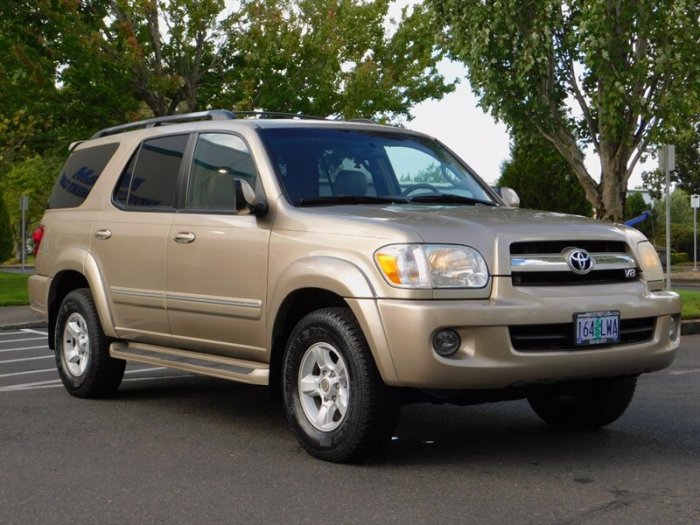
The 2006 Toyota Sequoia stands as a testament to the brand’s commitment to building reliable and capable SUVs. While it may not have the latest technology or fuel efficiency of newer models, its spacious interior, powerful engine, and reputation for durability make it a compelling option for those seeking a used full-size SUV.
Whether you’re a family looking for a spacious and comfortable vehicle or an adventurer seeking off-road capability, the 2006 Sequoia offers a compelling blend of features and performance.